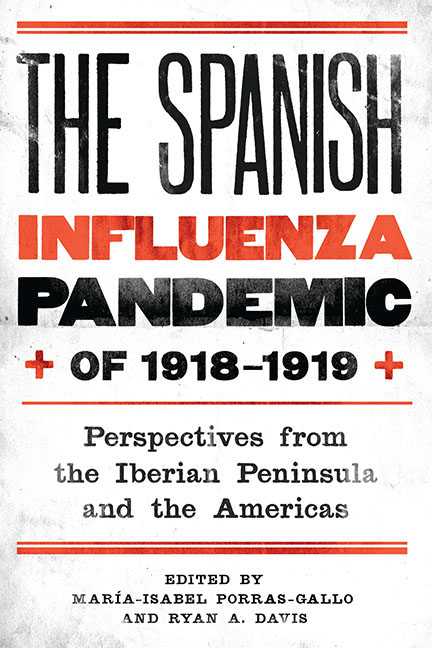 The Spanish Influenza Pandemic of 1918–1919
The Spanish Influenza Pandemic of 1918–1919 Book contents
- Frontmatter
- Dedication
- Contents
- Introduction: Emerging Perspectives of the Spanish Influenza Pandemic of 1918–19
- Part One Scientific Discourse: Now and Then
- Part Two Social Responses: Human and Institutional Actors
- 4 And to Make Things Worse, the Flu: The Spanish Influenza in a Revolutionary Portugal
- 5 Between the Pandemic and World War I: The 1918–19 Influenza Pandemic in the Spanish Army, through the Eyes of the Press
- 6 The Reign of the Spanish Flu: Impact and Responses to the 1918 Influenza Pandemic in Minas Gerais, Brazil
- 7 The Spanish Flu in Bahia, Brazil: Prophylaxis and Healing Practices
- 8 A Collaborative Experience: The Mutual Benefit Societies’ Responses to the 1918–19 Influenza Pandemic in Pamplona, Spain
- Part Three Interpreting the Epidemic: Sociocultural Dynamics and Perspectives
- Selected Bibliography
- List of Contributors
- Index
6 - The Reign of the Spanish Flu: Impact and Responses to the 1918 Influenza Pandemic in Minas Gerais, Brazil
from Part Two - Social Responses: Human and Institutional Actors
Published online by Cambridge University Press: 14 March 2018
- Frontmatter
- Dedication
- Contents
- Introduction: Emerging Perspectives of the Spanish Influenza Pandemic of 1918–19
- Part One Scientific Discourse: Now and Then
- Part Two Social Responses: Human and Institutional Actors
- 4 And to Make Things Worse, the Flu: The Spanish Influenza in a Revolutionary Portugal
- 5 Between the Pandemic and World War I: The 1918–19 Influenza Pandemic in the Spanish Army, through the Eyes of the Press
- 6 The Reign of the Spanish Flu: Impact and Responses to the 1918 Influenza Pandemic in Minas Gerais, Brazil
- 7 The Spanish Flu in Bahia, Brazil: Prophylaxis and Healing Practices
- 8 A Collaborative Experience: The Mutual Benefit Societies’ Responses to the 1918–19 Influenza Pandemic in Pamplona, Spain
- Part Three Interpreting the Epidemic: Sociocultural Dynamics and Perspectives
- Selected Bibliography
- List of Contributors
- Index
Summary
When the 1918 influenza pandemic irrupted onto the world, Belo Horizonte, the capital of the state of Minas Gerais, Brazil, had been in existence for only two decades. Inaugurated on December 12, 1897, the city was constructed in accordance with the scientific knowledge of engineering and other propositions considered essential for the planning and good governance of urban spaces and was therefore proclaimed young and modern. Despite harking back to the colonial period, the project to construct a new capital in Minas became effective only with the arrival of the republic in 1889.
The construction of the new capital of Minas Gerais can be understood best within the context of the economic, social, and political modernization that characterized the Brazilian nation from the 1870s onward. The abolition of slavery in 1888 and the establishment of the republican regime in 1889 would be two cornerstones in this process, which had as one of its major scenarios the space of the cities. At the turn of the nineteenth and twentieth centuries, various Brazilian cities experienced the phenomenon of urban growth and its impacts on the social and economic order. The sanitary problems brought about by urbanization reaffirmed the association between disease and dirt and influenced the views of doctors and laypeople alike, thus conditioning the public imaginary about the city and grounding the many urban interventions undertaken by the authorities of that period. Another important association existed between progress and hygiene: the salubrity of urban areas was seen as an index of modernity and civilization. This ideal permeated the history of the new capital from the moment of its conception well until into the twentieth century.
Unlike the reforms seen in other Brazilian cities, which favored a particular area of the urban fabric, the project of the new capital of Minas ignored previous occupations and uses attributed by the population to the areas of the old town. The old town was completely destroyed to make room for a new city designed on paper. Buildings, squares, streets, and avenues were entirely new and predetermined, as were the activities housed in each region, with defined areas for commerce, housing, and administration. Palaces, boulevards, squares, and high-scale commerce were designed to give the new capital, bathed in fresh air and sunlight, a tone of civility and cosmopolitanism.
- Type
- Chapter
- Information
- The Spanish Influenza Pandemic of 1918–1919Perspectives from the Iberian Peninsula and the Americas, pp. 111 - 129Publisher: Boydell & BrewerPrint publication year: 2014
